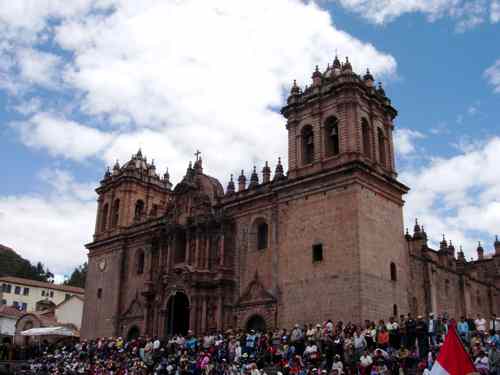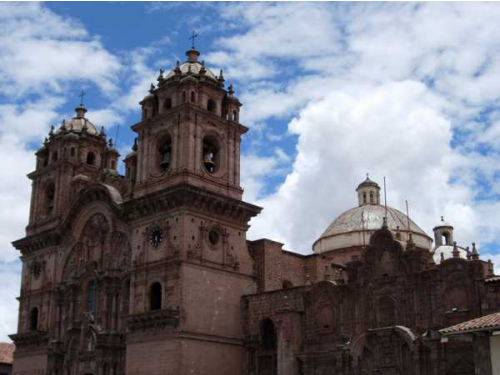Just after I arrived in Cusco — Peru’s third-largest city, and the jumping-off point for any trip to Machu Picchu — I toured the city’s massive cathedral. It’s not only a religious institution; it’s also a fine museum that showcases some 300 paintings. The works are mostly by the Cusco School (or Cuzco School) of the 17th and 18th centuries, which had European painters come to Cusco — once the capital of the Inca Empire — to teach local artists to paint in the European style. The results were beautiful, beatific, and occasionally bizarre. The indigenous artists converted to Catholicism, but they retained certain Inca ideas. For example, depicting Jesus in a loincloth was profoundly disrespectful in their eyes, so Jesus wears the knee-length linen skirt of the Inca nobility in scenes of the crucifixion. But the most famous departure from European tradition is in the rendering of the Last Supper. Forget Leonardo da Vinci: this version depicts Jesus and his disciples gathered around a table to enjoy a last supper of… guinea pig.
If you haven’t visited South America, it may come as a shock that a mammal North Americans take for a family pet is considered a delicacy (it’s called cuy in these parts). By the end of my week in Cusco, I was ready to give it a try. I finally had it at the MAP Café, the restaurant at Cusco’s Museum of Pre-Columbian Art (an offshoot of the renowned Larco Museum in Lima). The restaurant is one of the most extravagant and exceptional in the city, and its setting is unique — it’s essentially a glass box in an interior courtyard, surrounded by archways through which diners can catch glimpses of ancient art.
What impressed me most about the MAP Café was the service. When I showed the waiter my Spanish celiac disease card, he got the other staff members together so that everyone who would be working with my table would be aware of my gluten-free diet. The kitchen had a few questions about ingredients that weren’t mentioned on the card, including quinoa. I started with a dish that paired thinly sliced grilled alpaca with anchovies, followed by cuy confit with peanut-and-panca-flavored potatoes (panca is a type of Peruvian pepper, not to be confused with panko — Japanese breadcrumbs — which aren’t gluten-free). Cuy turned out to be an incredibly rich, strongly flavored meat (it doesn’t taste anything like chicken). For dessert, I had sautéed strawberries in a purple corn sauce, served with a corn-infused ice cream. It was an incredible gluten-free meal from start to finish, and while it was expensive compared to my other meals in Cusco, the three-course prix fixe menu included a glass of wine and cost only $35. Best of all, I had a fine introduction to just how appealing cuy could be.
MAP Café [address] In the Museo de Arte Precolombino, Plaza Nazarenas 231, Cusco, Peru [tel] 084-242-476 [website] www.cuscorestaurants.com


